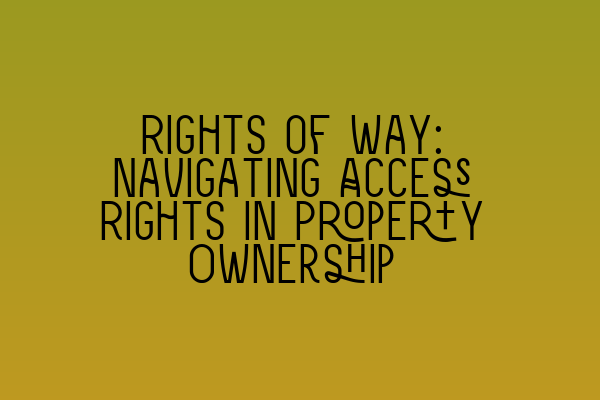Rights of Way: Navigating Access Rights in Property Ownership
When it comes to property ownership, there are many factors to consider. One important aspect that often arises is the issue of rights of way. Understanding access rights, both as a property owner and potentially as an adjoining landowner, is crucial to avoid conflicts and legal disputes.
What is a Right of Way?
A right of way refers to the legal right to pass through or over someone else’s property without obstruction. It provides individuals with a designated pathway for accessing their property or other areas. These rights are typically granted through legal agreements or by virtue of long-standing usage and custom.
There are several types of rights of way, including:
- Public rights of way: These are paths or roads that are legally accessible by the public. They are often maintained by local governments and can include footpaths, bridleways, and byways.
- Private rights of way: These are access rights that are specific to certain individuals or properties. They can be granted through legal agreements, such as easements, or through historic usage.
- Prescriptive rights of way: These arise when someone has consistently used a pathway for a specific period of time, typically 20 years or more. If the use is uninterrupted and without permission, a prescriptive right of way may be established.
It’s important to note that rights of way can either be registered or unregistered. Registered rights of way are recorded in official property registers and can be easily identified. Unregistered rights of way, on the other hand, may require further investigation or legal assistance to establish.
Understanding Your Rights as a Property Owner
As a property owner, it’s important to understand your rights and obligations when it comes to rights of way. Whether you have a private right of way on your property or are adjacent to a public right of way, you have certain responsibilities to ensure proper access is maintained.
If you have a private right of way, it’s crucial to respect the rights of those who benefit from it. This means not obstructing or interfering with their access, and maintaining the pathway to a reasonable standard. Failing to do so may result in legal disputes or claims for damages.
Similarly, if your property is adjacent to a public right of way, you must also respect the rights of the public to use the pathway. This includes not obstructing the path or impeding access. If you have concerns about the use of a public right of way, it’s recommended to seek legal advice to understand your options and obligations.
Resolving Disputes
Disputes over rights of way can be complex and contentious. If conflicts arise, it’s best to seek legal advice to understand your rights and potential remedies. Mediation or negotiation may be possible to reach a resolution without resorting to court proceedings.
In some cases, it may be necessary to apply to the court to enforce or establish a right of way. This can be a complicated process and should be done with the assistance of an experienced property law solicitor.
If you believe that your rights of way have been infringed upon or if you are facing a dispute regarding access rights, it’s crucial to act promptly and seek legal advice. Ignoring or delaying action can have detrimental effects on your rights and may limit your options for resolution.
